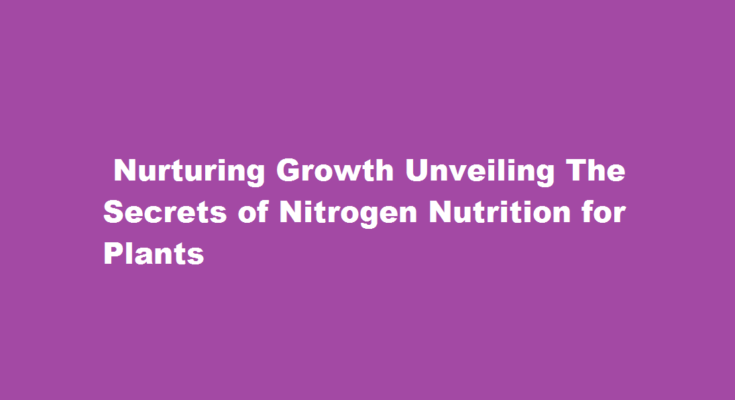Introduction
Plants, like all living organisms, require essential nutrients for their growth and development. Among these, nitrogen plays a vital role as it is a crucial component of proteins, enzymes, chlorophyll, and nucleic acids, making it an essential building block of life. In nature, plants can obtain nitrogen from various sources, but human interventions have become necessary to provide adequate nitrogen to meet the demands of modern agriculture and gardening practices. In this article, we will explore the significance of nitrogen for plants and outline various methods of providing nitrogen to ensure their healthy growth and productivity.
The Importance of Nitrogen for Plants
Nitrogen is a fundamental nutrient that influences numerous aspects of plant health. It directly impacts a plant’s vegetative growth, leaf development, and overall vigor. Plants that lack sufficient nitrogen often exhibit stunted growth, yellowing leaves, and reduced productivity. Therefore, it is essential to understand the mechanisms of nitrogen assimilation and the various ways to provide it to plants effectively.
Soil Management and Organic Matter
One of the primary sources of nitrogen for plants is the soil. Healthy soil teems with microorganisms that help break down organic matter into nitrogen compounds. By incorporating organic matter into the soil, such as compost, manure, or plant residues, gardeners can improve the soil’s nitrogen content. This gradual release of nitrogen from organic matter ensures a steady supply to plants, reducing the risk of over-fertilization and environmental pollution.
Nitrogen-Fixing Plants
Some plants have a unique ability to convert atmospheric nitrogen into a usable form through a process called nitrogen fixation. Legumes, such as peas, beans, and clover, host nitrogen-fixing bacteria in their root nodules. These bacteria convert atmospheric nitrogen into ammonia, which the plants utilize for growth. Intercropping nitrogen-fixing plants with other crops can enhance the overall nitrogen content of the soil and promote sustainable agriculture.
Synthetic Nitrogen Fertilizers
In modern agriculture, synthetic nitrogen fertilizers play a crucial role in meeting the high demands of crop production. These fertilizers are manufactured using the Haber-Bosch process, which combines atmospheric nitrogen with hydrogen to create ammonia-based fertilizers. While synthetic fertilizers provide a quick and concentrated source of nitrogen, their excessive use can lead to environmental issues such as soil degradation, water pollution, and greenhouse gas emissions.
Slow-Release Fertilizers
To address the drawbacks of synthetic fertilizers, slow-release fertilizers have been developed. These fertilizers contain nitrogen in a form that gradually releases nutrients over an extended period, ensuring a steady supply to plants. Slow-release fertilizers not only reduce the risk of nutrient leaching but also improve nutrient uptake efficiency, promoting healthier plant growth.
Liquid Fertilizers
Liquid fertilizers offer a convenient and efficient way to provide nitrogen to plants. These fertilizers are dissolved in water and can be applied directly to the soil or sprayed onto plant foliage. Foliar application of liquid nitrogen fertilizers allows for rapid absorption, making it an ideal option to correct nutrient deficiencies in plants swiftly.
Crop Rotation and Cover Crops
Implementing crop rotation and cover cropping practices can significantly contribute to nitrogen management in agricultural systems. Crop rotation involves alternating the types of crops grown in a particular area over successive seasons. Some crops, like legumes, add nitrogen to the soil, while others may have higher nitrogen demands. By rotating crops strategically, farmers can optimize nitrogen utilization and reduce the need for external inputs.
Frequently Asked Questions
What is the most common source of nitrogen for plants?
Plants need nitrogen to grow, develop and produce seed. The main source of nitrogen in soils is from organic matter. Soils in Missouri commonly contain one to four percent organic matter. Organic matter largely arises from plant and animal residues.
How much nitrogen do plants need?
Soil should contain an adequate supply (40 ppm) of nitrogen (N) when the garden is planted. A soil test conducted the previous fall or in early spring is the best way to determine if more nitrogen is needed. As the plants use up the soil’s supply of nitrogen they become starved for more.
Conclusion
Nitrogen is an indispensable nutrient for plant growth and development. Understanding how to provide nitrogen to plants in an efficient and sustainable manner is essential for modern agriculture and gardening. By adopting practices such as soil management, organic matter incorporation, nitrogen-fixing plants, slow-release fertilizers, liquid fertilizers, crop rotation, and cover crops, we can strike a balance between promoting healthy plant growth and minimizing negative environmental impacts. As responsible stewards of the earth, it is our duty to ensure that nitrogen is provided to plants in a manner that sustains their growth while safeguarding the planet for future generations.
Read Also : Cancelling a Cheque A Step-by-Step Guide to Secure Transactions



